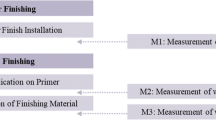Abstract
In the past decade, a growing interest of scientific researches has indicated that the air within the buildings can be more seriously polluted than the outdoor air. Indoor pollution has increased due to variety of factors including the construction of more tightly sealed buildings, the use of synthetic finishes and furnishings, and the use of chemically formulated personel care products. The presence of the sources that release gases or particles into the air are the main causes of indoor pollution in buildings, and in this context in hospital buildings. The indoor pollution bounds the indoor air quality (IAQ). To identify sustainable IAQ of the hospitals, the determinants of IAQ such as “indoor pollutants”, “indoor pollutant sources”, “indoor pollutant removal mechanisms”, and “the health effects of indoor pollutants” are discussed within the context of indoor pollution in the current paper. Furthermore, a comprehensive approach to hospital building design dealing with the sustainability criteria from cradle to grave process is presented.
Access this chapter
Tax calculation will be finalised at checkout
Purchases are for personal use only
Similar content being viewed by others
References
Levin H (2006) Ten basic concepts for architects and other building designers: Best sustainable indoor air quality practices in commercial buildings. Santa Cruz, USA http://www.buildinggreen.com/elists/halpaper.cfm
Çelebi G, Aydın AB (2001) Architectural responsibilities within the context of sustainability. Livenarch 2001, Livable Environments and Architecture International Congress Proceedings, Karadeniz Technical University, Department of Architecture, Trabzon, Turkey, 4–7 July, 2001, pp 140–146
Andrew SJ (1992) Sourcebook of sustainable design. Wiley, New York
International Organization of Standardization (ISO) (2003) Environmental management – life cycle impact assessment – examples of application of ISO 14042, ISO/TR 14047: 2003(E). Geneva
National Safety Council (2004) http://www.nsc.org/ehc/indoor/iaqfaqs.htm
Metropolitan Washington Council of Governments – Metropolitan Washington Air Quality Committee (MWAQC) http://www.mwcog.org/environment/air/indoor/
US Environmental Protection of Agency (2006) http://www.epa.gov/iaq/
Cheong KW, Chong KY (2006) Development and application of an indoor air quality audit to an air-conditioned building in Singapore. Build Environ 36(2):181–188
Jonsson A (2000) Is it feasible to address indoor climate issues in LCA?. Environ Impact Assess Rev 20(2):241–259
Erlandsson M, Borg M (2003) Generic LCA – methodology applicable for buildings, constructions and operation services-today practice and development needs. Build Environ 38(7):919–938
Zhang Z, Wu X, Yang X, Zhu Y (2006) BEPAS - a life cycle building environmental performance assessment model. Build Environ 41(5):669–675
Pastuszka JS, Marchwinska-Wyrwal E, Wlazlo A (2005) bacterial aerosol in silesian hospitals: Preliminary results. Polish J Environ Stud 14(6):883–890
Leyten JL, Kurvers SR (2006) Robustness of buildings and HVAC systems as a hypothetical construct explaining differences in building related health and comfort symptoms and complaint rates. Energy Build 38(6):701–707
Paulsen J (2001) Life cycle assessment for building products – the significance of the usage phase. Ph.D Thesis, Kungliga Tekniska Hogskolan, Stockholm, Sweden
Bouza E, Pelaez T, Perez-Molina J, et al (2002) Demolition of a hospital building by controlled explosion: the impact on filamentous fungal load in internal and external air. J Hosp Infect 52(4):234–242
Holcatova I, Benesova V, Hartlova D (2003) Comparison of the environment in operating theatres in two hospitals. Indoor Built Environ 12(1–2):121–124
Mills F. Indoor air quality standards in hospitals. Construction and Building Services Group, Institute of Mechanical Engineers (IMechE) http://www.touchbriefings.com/pdf/13/hosp031_p_MILLS.PDF
EPA document # 402-K-93-007: A guide to indoor air quality’, United States Environmental Protection Agency and the United States Consumer Product Safety Commission Office of Radiation and Indoor Air (6604 J), 1995
Department of Health Service (1996) Reducing occupant exposure to volatile organic compounds (VOCs) from office building construction materials: Non-binding guidelines, USA
Nazaroff WW, Weschler CJ (2004) Cleaning products and air fresheners: exposure to primary and secondary air pollutants. Atmosp Environ 38(18):2841–2865
Shilton V, Giess P, Mitchell D, et al (2002) The relationships between indoor and outdoor respirable particulate matter: Meteorology, chemistry and personal exposure. Indoor Built Environ 11(5):266–274
Nordstrom K, Norback D, Wieslander G (1999) Subjective indoor air quality in geriatric hospitals. Indoor Built Environ 8(1):49–57
US Environmental Protection of Agency (2006) http://www.epa.gov/iaq/largebldgs/i-beam_html/ch1-fund.htm
Heimlich JE. Sick building syndrome. Ohio State University; http://ohioline.osu.edu/cd-fact/0194.html
Kipen HM, Fiedler N (2002) Environmental factors in medically unexplained symptoms and related syndromes: the evidence and the challenge. Environ Health Perspect 110:597–599
Eberlein-Konig B, Przybilla B, Kuhnl P, et al (2002) Multiple chemical sensitivity (MCS) and others: allergological, environmental and psychological investigations in individuals with indoor air related complaints. Int J Hyg Environ Health 205(3):213–220
Author information
Authors and Affiliations
Corresponding author
Editor information
Editors and Affiliations
Rights and permissions
Copyright information
© 2010 Springer-Verlag Berlin Heidelberg
About this chapter
Cite this chapter
Dikmen, Ç.B., Gültekin, A.B. (2010). Sustainable Indoor Air Quality (IAQ) in Hospital Buildings. In: Gökçekus, H., Türker, U., LaMoreaux, J. (eds) Survival and Sustainability. Environmental Earth Sciences. Springer, Berlin, Heidelberg. https://doi.org/10.1007/978-3-540-95991-5_50
Download citation
DOI: https://doi.org/10.1007/978-3-540-95991-5_50
Published:
Publisher Name: Springer, Berlin, Heidelberg
Print ISBN: 978-3-540-95990-8
Online ISBN: 978-3-540-95991-5
eBook Packages: Earth and Environmental ScienceEarth and Environmental Science (R0)




